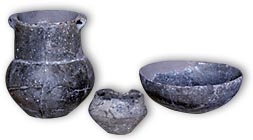- Home
- Time and place
- From the Neolithic to The Chalcolithic in Dobrogea
- Cernavoda I Culture
Part of a limestone "scepter" with representation of horse head with harness Cernavoda I culture. This object, probably a symbol of power, brings direct proof of the use of horses by the people of the Pontic steppes (origin : Casimcea, district : Constanta).
Site eponym : Cernavoda "Dealul Sofia" on the right bank of the Danube in Dobrogea.
Dates : End of the ancient Chacolithic, middle of the fourth millennium, BC.
Geographical Setting : Probably a progressive migratory movement coming from the Pontic steppes. A territory essentially covering Dobrogea, the east of Muntenia and the northeast of Bulgaria.
Habitation : situated on the mountainsides or in the highlands, re-occupying the Gumelnita culture settlements sometimes and often surrounded by ditches.
Material Means : Almost a complete rupture from the previous culture's development. Use of shell chips and clay with rope or cord-style are very characteristic of the pottery and ceramics. Stone scepters. Limited use of copper.
Funeral Rites : Burial and graves under funeral mounds or flattened pits, both isolated and grouped in to a Necropolis.
Through its Eneolithic elements, the Cernavoda I culture completes a major stage of cultural evolution and marks the transition between the Neolithic era and the Bronze Age with its new social and cultural structure. Through an uninterrupted cultural evolution, from new historical transformations, beginning with Cernavoda I and continuing with Cernavoda II and Cernavoda III, we arrive at the foundation of Indo-European culture.
The Cernavoda I culture is diffused throughout an area covering Dobrogea, east of Munténie and North-East of Bulgaria. Its relationships to the other cultures are, however, much more intense notably its contacts with Cucuteni A4 and AB, Usatovo, Foltesti, Maiaki, Salcuta, Bodrogkesrestur, Suplevce, Troia I, Ezero...
The Cernavoda culture belongs to a great, relatively homogeneous, group of cultures characterized by ceramics with twisted decoration, the use of ochre, scepters in zoomorphic forms, and burial under grave mounds.
From a chronological point of view 3450 BC - 3000 BC, The Cernavoda I culture is one consistent Neolithic culture yet the tools and technology are indicative of the Eneolithic, if only for what it inherited from the Gumelnita culture.
The infiltration of the Cernavoda I culture seems to have been quite rapid, even violent. The lower Danube region (where Cernavoda and Hârsova are located) is in the center of a vast zone of cultural mixtures and ethnic migrations. The more one moves away from the lower Danube, the more diffused the Cernavoda I elements become, and the more quickly the Cernavoda I tribes were assimilated. The Cernavoda culture follows a evolution parallel to a series of other Eneolithic cultures. It brought "cultural advances" between Troy and the Carpathians and loaned elements of the Gumelnita culture to the territory on which it settled in the lower Danube.
Group of ceramics from the Cernavoda culture (origin : Hârsova).
La culture Cernavoda appartient à un grand groupe de cultures relativement homogène caractérisé par des sépultures sous tumulus, l'usage de l'ocre, de la céramique à décor cordé, et de sceptres zoomorphes...
Du point de vue chronologique (3450 - 3000 avant notre ère) la culture Cernavoda I est une culture néolithique mais ses éléments matériels la rattachent à l'Énéolithique (mais seulement pour ceux hérités de la culture Gumelnita). La pénétration de la culture Cernavoda I paraît avoir été très rapide, peut-être même violente. La région du Bas Danube (où se situent Cernavoda et Hârsova) se trouve au centre d'une vaste zone dans laquelle se sont produits des migrations ethniques et des mélanges culturels. Plus on s'éloigne du Bas Danube, plus les éléments Cernavoda I sont diffus et plus les tribus Cernavoda I ont été rapidement assimilées. La culture Cernavoda a évolué parallèlement à une série d'autres cultures énéolithiques. Elle a véhiculé des "biens culturels" entre Troie et les Carpates et a emprunté des éléments de la culture Gumelnita sur le territoire de laquelle elle s'est installée dans le Bas Danube.

